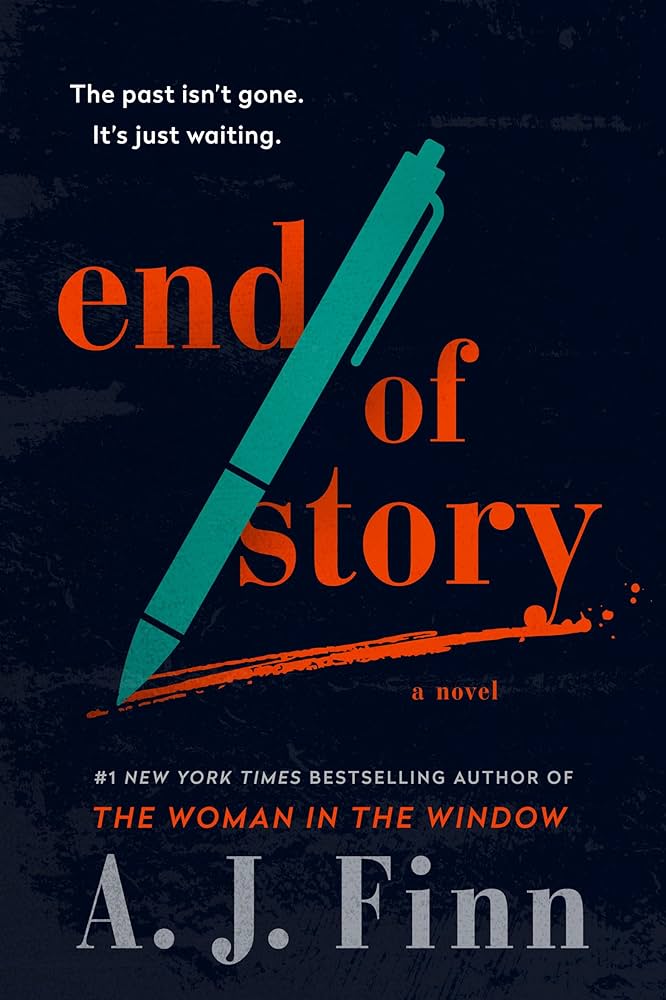
Library Journal listed End of Story as one of the “big books this week” (2/20/24).
A.J. Finn is known for his remarkable The Woman in the Window.

If you love reading about medical breakthroughs, you’ll love this memoir by Steffanie Strathdee. Her husband was the first person in the U.S. to receive phage therapy for his multi-drug resistant infection. None of it would have happened with her grit and determination. A riveting read.
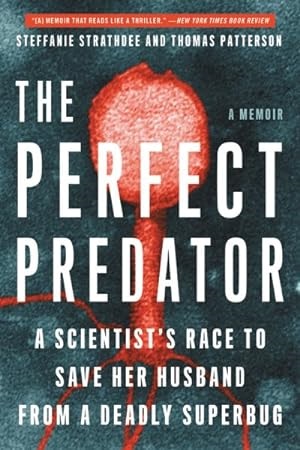

Set in New York, My Name is Lucy Barton, is a psychological portrait of a woman who has survived a terrible upbringing of cruelty and poverty. At the start of the novel, Lucy, who is temporarily hospitalized, received visits from her mother. Lucy is grateful for the visits and grateful for the doctor who seems to genuinely care for her.
Underneath the mother’s kindness, however, there is an undercurrent of cruelty. Lucy is the only one who has successful escaped her humble beginnings in Amgash, IL.
Lucy has gone to college and become a writer but she still experiences loneliness and disconnection. Once after Lucy has her first baby, she calls her mother. Her mother, however, refuses to accept the charges for the collect phone call.
This novel is set in the 1980s before cell phones and smart phones. Another crucial part of the novel is the AIDS epidemic; Lucy feels a connection with outcasts and with the neighbor who is dying.
The brothers and sisters she left behind in Amgash feel some resentment for Lucy, who made it out of the rural community. Those themes are explored in Strout’s award-winning short story collection, Anything is Possible.
Lucy discovers she will always be connected to her family even though she has left them and started life anew elsewhere.

Spineless is a fascinating memoir about a woman obsessed with jellyfish. Berwald became enamored with the marine life after taking a course in Israel. Once she explored the Red Sea coral, Berwald was hooked. After having children, though, Berwald felt sidelined by her options.
Though she faced many obstacles, Berwald’s slippery subject takes her to Italy, Japan, and Israel. In a journey that mirrors the life cycle of the jellyfish, Berwald’s becomes enthralled with the jellyfish’s story–their anatomy, their ability to reproduce in increasingly acidic waters and what that portends about the ocean’s future.

Like most of St. James’s novels, The Sun Down Motel invokes the supernatural. Strange events have been occurring at the Sun Down Motel since the eighties
Carly, who just lost her mother to cancer, decides to find answers to questions her family have been dodging for years–what really happened to her Aunt Viv.
The Sun Down Motel looks identical to photographs from the time Carly’s Aunt Viv worked the night shift there in the eighties.
The rumors prove true; Carly realizes the motel is haunted by several spirits. In the middle of the night, the lights go off and the locked doors open. While working at Sun Down she hears odd things and receives strange phone calls.
Fortunately, she has Callum and Nick, two locals who help her decipher Fell’s strange history. Less helpful are Alma Trent, a retired police officer, and Marnie, a freelance photographer. Both know what happened to Viv yet each refuses to disclose it.
In the novel’s alternate eighties timeline, Viv’s story unfolds. Like Carly, Viv has an intense drive and curiosity about murder. Viv solves the murder cases yet she naively puts herself in the murderer’s path.
What’s best about the novel is the way the two women (Viv and Carly) mirror each other. Both are courageous and fiercely determined to solve crimes. The surprising twist at the end will enthrall most readers. The closure Carly receives is well-deserved and earned.

The premise of Every Heart a Doorway is that the universe extends an invitation to certain children: a door to a new world. This new world, whether it be called Confection, or Prism, or Halls of the Dead is a magical place where the individual feels completely at home.
Some of these children are never seen again. Others are for whatever reason forced or told to return to real world for a short time. These children who have made this magical journey are heart-broken when they find themselves back in the real world
All of the students that end up at Eleanor West’s School for Wayward Children want desperately to find the door and the world that claimed them.
Eleanor tells the parents of these children that she will offer group therapy and that she will shatter their delusions. Eleanor actually sees her school as a “way station.” She wants nothing more than to help them find their door again, even if the odds are against it.
Just as Nancy, a new student, learns to navigate her way around the school, the unthinkable happens. Her roommate, Sumi, is murdered, the body mutilated.
Everyone suspect Jack (short for Jacqueline) because she has been to harsh world called the Moors. She and her twin sister were both in service to a Lord Vampire.
When two more bodies appear, the magical fantasy becomes a mystery.
Seanan McGuire who also writes horror as Mira Grant blends genres in this slim, yet well-plotted fantasy.
Every Heart a Doorway won a Nebula award in 2016 for best novella as well as a Hugo award(2017)and Alex award (2017).

Station Eleven is about the Georgia virus, one that is even more disrupting than COVID-19. In this prescient novel, Mandel writes about a virus that ends civilization, eliminating people quickly and with them the knowledge of technology. After it hits, there’s no electricity, phone, internet, cars, law enforcement, hospitals, or government. Bands of survivors that set up settlements in abandoned restaurant, hotels, and airports.
The principal characters are all connected in some way to a King Lear production that took place shortly before the collapse in Toronto. An aging actor, Arthur, dies on stage; the actor’s childhood friend, Clark, and a child actress in the production, Kirsten, survive.
While this is a grim scenario, Mandel cleverly knits the factions together. Jeevan, for instance, is an aspiring paramedic that rises out of the audience to try to rescue Arthur. His story interconnects with Kirsten’s and the roaming Symphony that band together for art’s sake after the collapse.
Kirsten believes that “survival is insufficient.” In addition to survival, there must be beauty and art; thus, she continues to perform Shakespeare with the Symphony in spite of the hazards. The Symphony sometimes wander through dangerous territory and encounter sinister people such as the mysterious Prophet.
The Symphony are all armed and trained, even if they aspire to preserve beauty. Kirsten is an expert knife-thrower who can defend herself in necessary. The Prophet, in contrast, is an armed aggressor who takes what he wants, including children, as his wives. He kills without regard and proclaims himself the “Light.””
The Prophet is also connected, Clark soon learns, to his old friend Arthur. Miranda is linked to Arthur and it is her graphic novel, Station Eleven, that provides a clue to the Prophet’s origins. Everything is wonderfully knotted together, its up to the reader to unravel the connections.
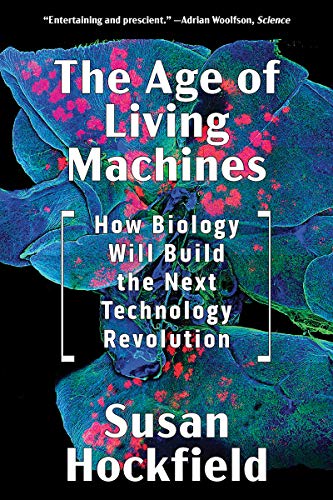
Susan Hockfield, President Emerita of MIT, discusses the beneficial convergence of biology and engineering. She describes viruses that can generate electric charges, proteins that can act as water filters, nanoparticles that can target unhealthy cells, prosthetic limbs that can work as ordinary limbs do, and data-driven crop yields.

In Yesterday’s Kin members of the scientific community try to stop an airborne virus from harming earth’s population. A ship full of aliens from World have warned Earth ten months before Earth will make contact with a virus-filled cloud.
Notably, Kress wrote Yesterday’s Kin in 2014 well before the current Covid crisis. While the panic and the desperate quest for a vaccine are eerily familiar, this story focuses upon genetics and family connections.
This story revolves around Marianne Jenner and her three children, Ryan, Elizabeth, and Noah. Noah, the youngest, has always felt like an outcast–the black sheep of the Jenner family. These feelings of alienation grow worst after he learns that his family has been hiding a secret from him.
In Kress’ story, the country is divided by politics which make the crisis worst. Few trust the aliens and the joint scientific venture taking place in the Embassy. A terrorism situation creates additional heartbreak and tragedy.
Kress skillfully interweaves scientific facts about DNA and the genetic bottleneck, that occurred 70,000 years ago, with fiction.

Quirky and off-beat, yet heart-felt, this novel will astound you. At times, its laugh-out-loud funny and other times profoundly moving. At the heart of this idiosyncratic novel are the Rockwells who lives in Ocean City, N.J. They love to tell people they bear no relation to the illustrator, Norman Rockwell.
In fact, nothing about the Rockwells is typical. They come from a long line of profiteers and though they are rich, they are not sociable. They never go to the boardwalk and mingle with others who are not like them. The girls live with their eccentric Mom who claims their absent Dad is a U.S. spy.
Hurricane Sandy, one of the worst storms in history, brings upheaval and upends their world. After the storm badly damages a house, a man arrives at their door with a box of letters reportedly belonging to their absent Dad.
All of Augusta’s secrets start coming to the surface resulting ultimately in the girl confronting the old spy. Though he has been absent, he has critically interfered in their lives which infuriates the girls. The storm brings all the sisters in to confront their Dad on this while also brings past slights and recriminations to the surface.
Liv accused Ru, who is a writer, of stealing her life for the plot of her book. Liv and Esme are at odds. Liv has always considered herself the prettiest Rockwell girl. When Esme brings her own daughter, a wise-cracking, live-tweeting adolescent into the mix, things get further out of hand.
While Nick, the absent Dad, tries to make up for lost years, the girls realize several important truths. This novel about the bonds of sisterhood and the depth of parental love would make for a great book discussion.

Divided into three sections, this dystopian novel looks at beekeeping from three different vantage points–Victorian England, America circa 2007, and China circa 2098.
While ostensibly focusing on bees, the novel examines the tensions that exist between family members, especially fathers and sons. This is true for the Victorian century beekeeper, William, and his son, Edmund, and in his American descendants, George, and his son, Tom circa 2007.
The sons in each case want nothing to do with father’s dream of harvesting honey and raising bees. William Savage is not only estranged from his son but also becomes more and more alienated from his mentor, Rahm. The only child who understands William’s dream is Charlotte yet he coldly dismisses her achievements. She is the wrong gender.
In the last time period, which takes place in China, bees and other pollinators are extinct. Their absence which leaves a void in the world further alienates family members. Without bees, everyone is undernourished and forced to work long hours hand painting pollen onto flowers.
In this horrific time, parents can only see their children one day a week. Children are forced to leave school and work as pollinators at younger and younger ages. Tao and Kuan can barely speak to each other, especially after their son disappears. Tao leaves her husband and goes off into unsafe areas of Beijing in search of her child, Wei-Wen.
Tied into all three stories is The History of the Bees, a book written by Thomas Savage who is distantly related to the Victorian bee keeper. Tao read the book and insists that the leader of the Committee, Li Xiara, read it as well.
The army and Chinese government finds a new colony of bees near the site where Wei-Wen goes missing. Knowing and acknowledging the past, however, is necessary before they can move forward. Tao’s boy becomes a symbol of hope.
What is fascinating is the way Lunde compares the disappearance of bees, also known as colony collapse disorder, with the disintegration of family and natural bonds. This is a chilling speculative novel about what may happen if red flags about pollinators and the climate are ignored.
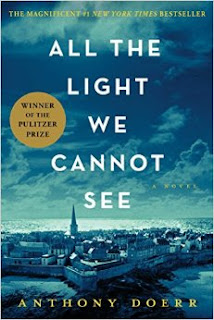
Two young people’s live intersect when American bombers head for St. Malo, the last German stronghold.
Only a rare writer can develop such nuanced characters or create such beautiful moral complexities.
Wherever he goes, Werner hears his sister Jutta’s sad question reverberating in his head: Is it right to do something only because everyone else is doing it?
Marie-Laure who is involved in the resistance with her Uncle Etienne wonders if they are the “good guys.”
Neither knows the meaning of the numbers Etienne recites into the clandestine radio transmitter.
Tension builds as both Marie-Laure and Werner become trapped. Werner is trapped under a hotel, L’Abeille, when it is hit by Allied bombs. Marie-Laure is trapped in her great Uncle Etienne’s secret room in the attic.
Sergeant Major Von Rumpel frantically searches the house for the gem, The Sea of Flames, the one Marie-Laure’s father has sworn to protect.
Tired of hiding, Marie-Laure nearly gives herself away. Werner, who has managed to escape from his own ruin, decides to make things right in the only way he has left.
All the Light We Cannot See is a contemplative, well-researched novel. All The Light You Cannot See won the 2015 Pulitzer Prize for fiction and the 2015 Andrew Carnegie Medal for Excellence in Fiction. Recently, it was adapted to film for Netflix.

A troubled girl and a widower strike up a friendship in Berg’s heart felt novel, The Story of Aruthur Truluv. Unwed and pregnant, Maddie spends a lot of her time in cemeteries where widower Arthur Truluv has lunch everyday.
Truluv has an uncanny of peering into the lives of the departed. Mostly, however, he goes to spend time with his late wife’s grave. The two of them had an unshakeable bond–one that Maddie comes to recognize as true love. Thus, she renames him “Truluv.”
In her own life, Maddie hasn’t been so lucky. Her father and her do not speak much and her mother died while she was young. Maddie’s boyfriend breaks up with her and takes no responsibility for their child.
Just when things seem hopeless, Maddie and Truluv comes up with a remarkable solution. This novel makes a solid case for the power of inter-generational friendships and communities.
In a terrific scene that shows Truluv’s devotion, Truluv defends Maddie against Anderson who comes around to pester her. Truluv nearly collapses from exhaustion but, for him, she is worth it.
Life is indeed, as Arthur points out, rather like a square dance. Many of these characters make a re-appearance in Berg’s later Mason novels, Night of Miracles, and The Confession Club.

Lea’s novel grew out of little known incident–Italian POWs were made to build barriers during World War II to protect the Orkney islands. During their time in the Orkneys, the prisoners built a beautiful chapel out of scrap metals and other left over materials.
In her version of events, the prisoners are brought to a mostly uninhabited island. Since the island has an eerie reputation, only two sisters, Con and Dot, live there. The pair have been isolating themselves to escape Kirkwall, the main island where both have suffered a terrible ordeal.
The sisters decide to work at the camp’s infirmary where Dot becomes charmed by one of the prisoners, Cesare. Though Con opposes the relationship, Dot and Cesare fall in love. Despite hardships and the cruelty of one of the guards, Angus Macleod, Cesare is granted permission to build a chapel.
The chapel plays a part in Dot and Cesare’s escape plans. While everyone is celebrating Michelmas, the POWs plan a diversion that may allow them Cesare to escape. Filled with bile, Angus, who despises Cesare, works to thwart their plans.
This is a haunting story about trauma, vengeance, sacrifice, and enduring love.
World War II – Building the Barriers – Orkney Museum (wordpress.com)

Stott blends fascinating historical details about the Seax (Saxon) culture with myth and fantasy. The two narrators are daughters of the Great Smith who have been banished to a mudflat island.
Seax culture is full of rules. Women are not even allowed to step foot in the smithy shop since it is considered a male domain. Ignoring these rules, Isla has worked as her father’s striker. He has taught her the coveted craft of forging Firetongues.
When he unexpectedly passes, the girls place in society suddenly changes. They suddenly need to get off the island and claim kin law–ask Osric for protection. Instead of gaining his protection, however the sisters gain Osric and his son’s (Vort’s) wrath. They must flee the camp and enter the ghost city, the remains of Londinium, where most Seax fear to enter.
While the ghost city and its inhabitant give them a much needed shelter, leaving the ruined city is a necessity. Blue wants to wait for Cassius but Isla fears this is a mistake. If they wait too long, winter will find them. Besides, Senna tells them that trackers can breach the city, especially after the Seax offer a reward for the sisters’ capture.
Even without a man’s protection, these sisters do more than survive in this dark ages adventure–they triumph.
This novel is written for adults but it will likely have a lot of cross over appeal to young adults.

Sisi’s fairytale wedding does not lead to happiness and fulfilment. Sisi enjoys astounding wealth yet feel confined–a bird in a gilded cage. Deeply unhappy, Sisi travels to Hungary where she befriends Count Andrassy and then to England where she befriends the dashing Captain Middleton. Her hunting trips, travels and friendships however, cause the press to criticize and ridicule her.
In her novel Pataki gives readers an unvarnished glimpse of royal life in the Hapsburg court. The narrative flow is not impeded by the historical figures she inserts into the story. She recounts King Ludwig of Bavaria’s tragic downfall and the implications it has for the Hapsburgs. The Hapsburg motto is “We don’t change” yet change is inevitable.
Perhaps no one is as adamant about royal protocol than the Archduchess Sophie, Sisi’s mother-in-law, who cruelly separates Sisi from her own children. Sisi valiantly rescues Rudolph from his tutor’s cruelty but the damage is done. Like the real life counterpart, the Crown prince of this novel remains discontent and troubled. To him, Pataki ascribes the most prophetic dialogues.
Beloved by the people, demeaned by the press, Sisi takes comfort in traveling, even as she and her husband become more and more estranged. The damage of keeping up an appearance for the public’s sake is something many titled people and celebrities face. Pataki captures this internal conflict perfectly as Sisi struggles to fulfill her royal duties.
Informative and well-researched, this story is also an entertaining read.

If you enjoy reading about this time period, you may also enjoy reading,
Goodwin, Daisy. The Fortune Hunter.

Potzsch, Oliver. The Ludwig Conspiracy.
Torgov, Morley. The Mastersinger From Minsk.

Netflix’s Empress, and the feature film Corsage are two new films about the life of Empress Elizabeth of Austria.

Kim Richardson humanizes the Blue Fugates of Kentucky with her fictional take on a brave girl who becomes a pack horse librarian. For having blue skin, she is shunned, yet she succeeds in becoming a “book woman” and wins over the hill people on her route.
Cussy Mary or Bluet as she is called just wants to do her job, yet a preacher aims to stop her. His actions result in a series of catastrophic events and forces Bluet to participate in Doc’s scientific studies of her blue skin.
Though she tried to become white, some refuse to accept her. A few of the hill people, however, recognize her value. Angeline is the first to do this privately and later Jackson will take a more public stand.
Richardson writes about the marginalized–the Blues, the African Americans, the hill people–and their struggles to rise above bigotry. More than that though, this a warm, entertaining story that will have readers cheering.

After her mother dies, Katy goes on a trip to Positano to grieve. She has tickets for two because originally Katy and her mother planned on taking the trip together. Positano had always been a place Carole treasured.
In Positano, Katy unexpectedly comes across the woman her mother used to be–the woman Carol was before she married her Dad and had a baby. That Carol was wild and carefree, utterly different from the woman she became–the perfect wife and mother.
In Positano, Katy runs into a version of Carol who was single and unencumbered–when all her dreams lay before her. At first Katy does not think much about this unusual occurrence. She is in Italy, after all, which is well-known for being timeless and magical.
Soon though Katy meets a man which makes her rethink her own marriage and life as well as Carol’s.
This is a playful novel that also makes readers ponder about free will and fate.
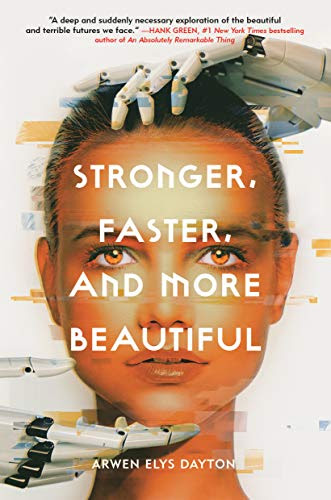
In Stronger, Faster, and More Beautiful, a young adult novel comprised of six loosely interconnected stories, Dayton gives readers a horrifying glimpse into the future. The stories grow increasingly dark and complex until the last one that ends with a sliver of redeeming hope.
In the first story, a twin is tricked into accepting a surgery that will make uses of his comatose twin’s healthy organs. He states unequivocally, “I wake up and know that my parents have tricked me, or rather, that they had the nurses drug me.”
In another story, a girl becomes traumatized after her romantic interest, Gabriel learns she has been genetically modified. A modified heart, artificial skin and a “meshline” has been added to her body. Betrayed by Gabriel and ostracized at school, Ludmilla exacts a terrible revenge on her persecutor.
These modifications, though protested by Rev. Tad Tadd’s followers, are more or less medical procedures. In the later stories, the ethical line between beneficial and deleterious procedures are further blurred.
In the third story or “part” called “The Reverend Mr. Tad Tadd’s love Story,” a girl learns that her father, the Reverend Tad Tadd has reversed course. When it was convenient to him, after losing his wife and son, he embraces the genomic technologies he railed against.
The procedures have become monstrous, and they are sometimes done without the individual’s consent. Plus, as Elsie points out its a convenient about-face for her Dad: “You’ve changed your mind now because someone you loved died. But — but — kids in hospitals…they’ve been dying all along.”
The modifications have become even more extreme in Part 4. An experiment to increase a boy’s intelligence has gone horribly wrong. His parents abandon him to a clinic which then transfers him to another clinic in Greece. His intelligence cannot be used for any practical purpose and his body has been exploited for the clinic’s cause.
In Part 5, a dying boy’s parents make a drastic decision — to have him cryogenically frozen so that a lifesaving procedure may be available for him at a later time. Unbeknownst to them, when he awakens he is transformed into a living machine — a slave used to mine platinum from asteroids. Not only that but the world is facing a new crisis — a Genome War.
In Part Six called “Curiosities” humans have modified themselves to the point of having wings and other vanities. They leave “Protos” on reservations, human beings who have not been modified, in order to study them. Eventually, the modified humans begins falling apart — their wings, jaws, and other modifications crumbling. Despite threats from a new group, the Naturalists, two Protos bravely enter the humans’ cities and choose to make a home there.
Moreover, this young adult novel shows that advanced in genomic technology brings both life-saving cures and the seeds for humanity’s self-destruction.

Bi-racial January has always felt out-of-place and ignored by her beloved father, Julian, who is a field agent for Mr. Locke, head of the New England Archaeological Society. Julian travels the world looking for rare objects for his benefactor and boss yet he rarely spend time with his daughter.
Lacking a father’s love and support, January turns to Mr. Locke. Though she tries to be Mr. Locke’s “good” girl, she has a taste for adventure that is abhorrent to him. While staying in Kentucky, January walks through a timber frame painted blue. Briefly, against all logic, she experiences a sea-swept world.
Though she does not know it yet, the world is rich with these “doors” that leak revolutionary ideas, people and objects. Mr. Locke and his society know about these doors, which they call aberrations, yet they are determined to close them. When January tries to revisit the world she encountered in Kentucky, she finds that the portal has mysteriously closed.
Harrow describes two warring factions–one open to new ideas and possibilities–and the other adamantly opposed to them. The novel is also a coming-of-age story, a love story and a thriller. January must escape from a number of her adopted father’s goons. Her courage and tenacity are tested to the limits after she is placed in one confining place after another, including an asylum. In the end, she must renounce her surrogate father who thinks of her as merely a “perfect specimen.”
She must find her own power that is separate from Julian’s. Julian, her true father, gives her the book, The Ten Thousand Doors which opens her eyes. He, however, believes once a door is closed, its closed forever. January must find a way to re-open the closed doors, find her real father, and sail her own ship. What a delightful and empowering read!
Alix E. Harrow’s most recent book is Starling House.

Sensible Alice always thought she would become a farmer. Even though she took a safe job in a county planning department, she always knew she would inherit the family orchard. After a series of losses, however, Alice finds herself alone and bereft of the family farm.
In a chance encounter, Alice meets another troubled person, Jake. A gifted musician, Jake has been paralyzed by a freak accident. When Alice realizes Jake has an affinity for bee keeping, she offers him a job. Before long she realizes she needs another employee to do carpentry work.
Alice not only gives the two young men jobs, she also offers them a place to stay at her small farm. This goes completely against her character. Multiple times in the novel Alice refers to herself as “Alice island,” or “Alice All Alone.”
Opening her home and her heart to these two young men is a big risk that pays off. Jake is able to tell her facts about the bees she missed. The seoncd one, Harry, is a nervous ex-con, yet he proves his worth when she needs him.
When a conglomerate, SupraGrow, threatens the small community’s livelihood, Alice and her new friends work together to protect the bees and orchards.
This novel which is about taking chances and building connections is an uplifting read that entertains and informs.
Eileen Garvin’s latest novel is Crow Talk.

Taking some time off from a stalled journalism career, Joanna never expects to be chasing another story in Faro, Portugal. That is exactly what happens when she enrolls in a language course and meets Nathan.
He alerts her to some underground activities that reignite her interest in investigative journalism. Joanna also realizes she has feelings for Nathan, even though she is convinced he is hiding something. His name, she discovers, is a false one.
Joanna’s story is tied to that of an American woman who lived in Portugal decades before, Esta Hartford. The wife of a war correspondent, Esta wrote a novel based on her life in Portugal in the 1940s. Though not widely read, Joanna discovers that the novel, The Alliance, is mostly a true account with some names changed.
To find out what is true and what is not, Joanna and Nathan embark on a dangerous quest to confront Algarve’s shadowy past. They confront criminals with ties to organized crime and shadowy figures from the intelligence community.
Neutral during the second World War, Portugal was a hotbed for espionage. Spies regularly met in hotel lobbies in Lisbon and in smaller cities, e.g. Estoril. Portugal was also a conduit for Nazis escaping capture at the war’s end. In more recent times, the area was the site a much publicized child abduction–the Madeline McCann case.
Lawerenson weaves all of this together in 300 Days of Sun. In the novel, the fairly recent child abductions are related to the pro and anti-Nazi factions that coexisted in Portugal. Nathan may have been an unwitting victim. Though he was adopted in England, he recently discovered that his birth certificate said that he was born in Portugal.
Novels where the past and present are inextricably linked can be fascinating. Joanna finds a kindred spirit when she reads the book The Alliance by Esta Hartford. Though they end up making different choices, Joanna can see many parallels between her own life and Esta’s.
by Chantal W.

Cornwell continues Uhtred’s story in the 2nd of the Saxon stories series and follows the battle of Cynuit. Brave, yet flawed, Uhtred continues to make rash decisions and incites King Alfred’s anger.
The complexity of the psychological development in Cornwell’s novel is startling. Uhtred is at war with himself almost as much as he is at war with Danes.
Uhtred is a stranger in Wessex, a pagan amongst Christians, who knows he will never be fully accepted, “I was an outsider. I spoke a different English. The men of Wessex were tied by family and I came from the strange North.”
Alfred, the only English king that would be known at ‘the great’, also has his own set of flaws. He often makes a hasty peace with the Danes rather than fighting them. He does not know how to rouse his men to battle and risks alienating those who would help him.
Even though he distrusts Uhtred for being a pagan, he realizes his importance and appoints him defender of his family after Cippanhamm falls: “Here and now I appoint you as the defender of my family.”
Against incredible odds, Alfred and the Saxons, who are marooned in a swamp, work together to build a fort and succeed in destroying Svein of the White Horse’s ships. The Danes, however, still control the area and outnumber the Saxon forces. To succeed, the Saxons will have to unite in a way they have never done before.
Iseult, yet another complex and intriguing created by Cornwell, predicts that Alfred will succeed. She claims there will be a “fight by a hill” and that the Saxons will defeat the Danes.
She alludes to the battle of Ethandum where the Saxons face two Danish armies, Svein and Guthrum. In this version of events, the Saxon army becomes dispirited until Uhtred bravely fights Svein outside of the shield wall. His actions turn the tide of the battle, resulting in the recovery of Alfred’s kingdom, Wessex.

Just as there may be an under painting hiding under a painting, nothing is as it seems in this novel. Everything is a trick of the eye. The singers that sing so well are actually eunuchs. The assistant that is supposed to be mute actually speaks a Neapolitan dialect. Alfonso is not a doting husband who treasures his new wife.
The Duchess realizes something is amiss when she hears him describe her as “my first Duchess.” This is the first moment that ascertains that she is disposable.
She always knew that she would be married to aggrandize her father’s rule:
“[H]ad it not been Alfonso it would have been someone else–a prince, another duke, a nobleman from Germany or France, a second cousin from Spain. Her father would have found her an advantageous match because that is, after all, what she has been brought up for.”
She expected him to command and she knew she would have to produce a male heir. She also knew that he surrounded himself with devious, heartless people like Leonello. What Lucrezia did not foresee was that the Duke of Ferarra is capable of killing those who would thwart his power.
The Duke wants a male heir so badly that he has Lucrezia follow a cruel regimen. Consequently, Lucrezia looks completely diffferent from the woman il Bastianino painted for the Duke, his marriage portrait of them.
When she fails to produce a son, the Duke takes her to his fortezza, a hunting lodge. The opening pages of the novel take us to this horrifying moment when Lucrezia knows she is in grave danger followed by a series of flashbacks.
O’Farrell constructs an illuminating portrait of Renaissance Italy in which women were traded among influential families. The Duchess is this story is so intuitive that recognizes the Duke’s machinations. Like a good thriller, this suspenseful story ends in a surprising way.
“If It Costs You Your Peace, It’s Too Expensive.”
Paul Coelho
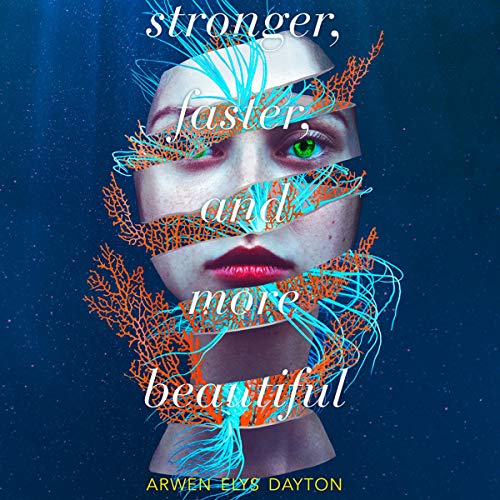
A science-fiction book that is also horrifying, Stronger, Faster, and More Beautiful is perfect for Halloween. What’s even scarier than Halloween tropes–ghosts, vampires, witches? Dayton’s Stronger, Faster, and More Beautiful suggests the casual use of gene-editing technology is even more horrifying.

Nebula-award winner and five time Hugo award winner, Michael Swanwick offers a startling collection of stories in Not Much Said The Cat.
Though the man in “The Man in Grey” says he is “nobody,” its clear there’s more to him than meets the eye. He tells Martha, “I am not a camera. I’m just the man who stands in grey, making things happen.”
He stops Martha from falling in front of a train because that wasn’t in the script. Yet, in a dramatic twist, Martha goes off script anyway.
The metaphysical idea that everyone is just a character in someone else’s story is explored to its fullest in “Goblin Lake.”
Besides playing with metaphysical ideas, many of the stories explore artificial intelligence and self-determination.
“The Dala Horse,” explores artificial intelligence in bots. The girl’s backpack is sentient and the small dala horse is a node who enters the girl’s consciousness and battles a white witch.
Many of these stories are involve space exploration and colonization, “For I Have Lain Me Down” and “The She-Wolf’s Hidden Grin.”
Almost each one of these stories could be expanded into full novels. Two characters in “Tawny Petticoats” appear in many more Michael Swanwick stories.
These stories fascinate because they present alternate histories, e.g. “Pushkin the American” and present chilling future possibilities.

In Wanderers an unknown pathogen wreaks havoc across the United States. The virus makes a zoonotic jump from bats to humans resulting in a pandemic, civil unrest, and pandemonium.
While all this sounds familiar to what we’ve just experienced with Covid-19, Wendig actually began devising the novel in 2016–four years before the Covid 19 outbreak.
In addition to the pathogen, characters also grapple with an AI that becomes sentient and autonomous, Black Swan.
Sadie explains how discomfiting the technology can be:
“Imagine that you create this thing, this quantum computer mind, and you begin to train it, and you realize it has a mind of its own. And then, on day, it tells you something: It has been speaking to itself in the future, and it believes that civilization will one day end.”
Though she believes she controls it, the AI begins to act independently. Predicting the pandemic, Black Swan takes control of a nanotech company and its swarm of nanotech bots. Black Swan’s actions ensure that a portion of humanity will survive albeit at a great cost.
The lives of a disgraced scientist, an aging rock star, a teen-aged aspiring photographer, and a preacher intersect in this trenchant novel. As they become personally drawn into the crisis, each of them grapples with the politicization of the pandemic and the moral uncertainties of AI.
If you enjoy The Last of Us, you may enjoy this novel.
Chuck Wendig has also written Star Wars: Aftermath (2015), Invasive (2016), and The Book of Accidents (2021).
Review by Chantal Walvoord

For a great introduction to an unsung hero, read Fiona Robinson’s The Bluest of Blues: Anna Atkins and the First Book of Photographs. Like Mary Anning and many other female scientists of the Victorian era, Anna Atkinson’s work was not fully appreciated during her lifetime.
Robinson explains in a clear style how Anna’s love for science was encouraged by her father, John Child. He was a scientist who had his own laboratory at his home in Tonbridge, England. He taught the young Anna himself and inspired her to follow his footsteps in the scientific field.
Robinson’s illustrations are mostly in Prussian blue and, thus, match the color of Anna Atkins’s cyanotypes. Characters, especially Anna, are wide-eyed and childlike, giving children a version of Anna that looks much like themselves.
Several scenes are set in the present giving the scenes a sense of immediacy. Several scenes begin “one morning” or “on this day.”
While Anna did not invent the cyanotype technology, she used this early form of photography in a new and innovative way. The photograms, as they are called, are much more life-like than an artist’s drawings that scientists of the day relied upon.

Robinson’s book serves as a great introduction to Anna Atkin’s and her groundbreaking work.
Robinson has also written book for young people about Lotte Reiniger, Out of the Shadows, and Ada Lovelace, Ada’s Ideas.
Chantal Walvoord

This wry book follows an unlikely cast of characters, an aging cleaning lady, an geriatric octopus, a homeless rock singer, a Scottish grocer, and a free-spirited entrepreneur as they move towards a better understanding of their lives.
Having been raised by an Aunt, Cameron desperately wants to find his Dad whom he thinks is a real estate tycoon. He moves to Sowell Bay on the slim chance of meeting and reconnecting, and possibly profiting from him.
The cleaning lady Tova finds herself drawn more and more to Cameron. The Giant Pacific Octopus at the aquarium where she works as a cleaner knows the reason. This particular octopus has the curious habit of escaping from his aquarium and placing objects or clues where people need to see them.
The octopus’s point-of-view is perhaps the most unique aspect of this humorous and touching novel. Marcellus knows he is dying–the lifespan of the octopus is incredibly short–yet he wants to help Tova before he goes. Tova is the only human whom he feels deserves his friendship.
Readers will find themselves pulling for this odd assortment of characters who have good intentions, even if they so easily bungle things.
By Chantal W.

Marie Benedict brings many historical figures to life in her novels. She intentionally choose women that have been overlooked by history. In her own words she writes about “unknown but key women of the past.”
Thus, she portrays Mileva Maric, in The Other Einstein, Hedy Lamar in The Only Woman in the Room, Churchill’s wife in Lady Clementine, Agatha Christie in The Mystery of Mrs. Christie.
She also co-wrote The Personal Librarian about Belle da Costa Greene, the personal librarian of J.P. Morgan, who hid her racial identity in order to work for one of the most powerful men.
One of the most astounding portraits is Rosalind Franklin in Benedict’s Her Hidden Genius. This novel gives us a real sense who Rosalind was as a person yet it also depicts the tremendous obstacles she overcame to pursue her scientific endeavors.
Rosalind faced resistance from her own family who wanted her to marry and work for Jewish charities. Mostly, though, she felt condescension from a small group of male scientists. Crick, Watson, and Wilkins, who won the Nobel prize, used her research–along with the famous photo 51 without crediting her.
Pair this book, Her Hidden Genius, with the non-fiction book, The Secret of Life.

Kim Richardson humanizes the Blue Fugates of Kentucky with her fictional take on a brave girl who becomes a pack horse librarian. For having blue skin, she is shunned, yet she succeeds in becoming a “book woman” and wins over the hill people on her route.
Cussy Mary or Bluet as she is called just wants to do her job, yet a preacher aims to stop her. His actions result in a series of catastrophic events and forces Bluet to participate in Doc’s scientific studies of her blue skin.
Though she tried to become white, some refuse to accept her. A few of the hill people, however, recognize her value. Angeline is the first to do this privately and later Jackson will take a more public stand.
Richardson writes about the marginalized–the Blues, the African Americans, the hill people–and their struggles to rise above bigotry. More than that though, this a warm, entertaining story that will have readers cheering.

Elizabeth Zott’s parents are frauds. Elizabeth and her scientific pursuits, however, is the real deal. She faces an uphill battle because the scientific community does not welcome women in the 1950s. Undetermined yet undeterred, Elizabeth squares off against Dr. Donatti at Hastings, a chemical laboratory.
What follows is hilarious series of misadventures and fortuitous coincidences that result not only in her vindication but a confirmation of all women’s value. Elizabeth Zott not only flips stereotypes in the male dominated scientific field but also reverses them in athletics and television production.
Like her husband, Calvin, she becomes accomplished at rowing. She also has charisma, in her own way, and wins over a sleepy viewership with her cooking/chemistry show. It’s easy to see why this novel is so popular with women but the characterizations of many of the male characters–Calvin, Mason, Wakely–is also positive and heartening. This is a delightful novel that will astound and inspire readers.
If you like Lessons in Chemistry, you may be interested in these non-fiction titles:
Bell, Jo. On This Day She.
Kaplan, Janice. The Genius of Women: From Overlooked to Changing the World.
Chantal Walvoord.

Don’t miss this complex, thrilling tale set in Orvieto, a hill town in Umbria, Italy. This new novel by Rachel Hawkins has many gothic elements, a suitable setting for the gothic novel, nineteen-year-old Mari is writing. Mari and Lara, and later Emily, come to the villa to work on their respective artistic endeavors.
The male rock stars they are traveling with assume that their work is negligible. Pierce assumes that Lara’s songwriting and singing abilities are not good as his yet it is her album that will become famous. No one expects Mari’s gothic novel to become a sensation yet it does. The women comes to realize their worth even if it comes at a great price.
Decades later, Emily and Chess come to this same villa to work on their writing careers. Having written several best-selling self-help books, Chess is the more famous of the two. Emily feels stalled and unable to complete her cozy mystery, but she hopes the villa and the medieval town will inspire her.
Like the coterie of rock stars and muses that lives in the villa in the seventies, the two contemporary women conceal many secrets from each other. Though they have been best friends since childhood, there relationship is a competitive one–similar to the one Mari and Lara have.
“The house remembers,” Mari writes in her gothic novel. By coming to to villa, Emily and Chess reawaken interest in a decades old murder, a love triangle, and a hidden manuscript.
In some ways, this book reminds me of Taylor Jenkins Reid’s Daisy Jones and the Six. Both novels depict up and coming rock stars and their rivalries and complicated love lives. This novel, however, has a dual timeline and suspenseful plot that are absent in the former.
Review by Chantal Walvoord

Review by Chantal
The House in the Pines is a chilling novel that demonstrates the dangers of psychological manipulation. Alternating between the present and the past, this novel introduces us to Maya who was once attracted to an older man, Frank.
Maya meets Frank shortly before she starts her freshmen year at Boston University. Though she only knows him a short while, he sends her life down a different trajectory.
After a handful of dates, Maya comes to the conclusion that Frank is dangerous. She is in the process of breaking up with Frank when her best friend, Aubrey, mysteriously dies. Maya believes Frank has something to do with Aubrey’s death but her theory sounds far-fetched and even delusional.
Seven years later, Maya returns to her hometown to investigate another death that Frank may have caused. In order to learn the truth, Maya must search her own psychologically traumatized soul.
More than just a thriller, Reyes writes about characters that are looking for their true homes. Though she never knew her father, Maya is half-Guatemalan. Part of solving the mystery before her is solving the mystery of who she is.
The House in the Pines is a Reese’s Book Club selection.
This wonderful historical novel dramatizes the struggles of real life historical figures, Dr. Korczak and Irena Sendler, who worked to help the orphans of the Warsaw ghetto.

In an attempt to isolate and starve the Jews, the Germans enclosed Warsaw’s Jewish population within 1.3 square miles. Janusz’s orphanage and school was relocated within these borders.
At first he and his colleague, Stefa, are hopeful that life would more or less remain the same. They are quickly disillusioned, however, as the situation turns more and more dire.
Janusz sees the best qualities and the worst qualities of human nature on display. He sees Jews that turn on themselves–the Jewish police–and one German officer who has qualms about what the Nazis are doing.
The same officer urges Janusz to save himself yet the doctor refuses to abandon his orphans.
I loved this work of fiction that celebrates the real life hero, Dr. Janusz Korczak and his accomplishments.

Contreras’s memoir is one woman’s reckoning with her family’s turbulent past and how it intersects with her country’s colonial legacy.
Ingrid is almost a clone of her mother. As it turns out the two share more than just their looks. Ingrid and her mother have both suffered from head injuries that have resulted in temporary amnesia that opens up mystical doorways.
The amnesia forces Ingrid, who grew up in Bogota, Columbia to re-examine what she knew about her life.
Her grandfather, Nono, is a curandero–a traditional healer who uses herbs and mysticism. Though he is not literate in the traditional sense, he is able to heal the sick and develops a following. Even after his death, his followers slip requests for miracles into his coffin.
The Contreras family migrates to the U.S. for safety after both sisters experience a a botched kidnapping. They suffer from trauma yet they deal with it in different ways. Ingrid is drawn to the supernatural, like her mother and grandfather while Ximena is a skeptic.
When Ingrid’s mami and the tias, and even Ingrid herself, have the same dream about Nono, they realize he wants rest. They return to Columbia to disinter his body and distribute his ashes in a river.
This memoir about family secrets and South American legends is an enjoyable read, especially if read with an open mind.

Set in the Italian alps, Flowers Over the Inferno, is fast-paced and chilling. Tuti comes from that region and she brings the fictional town of Traveni, a picturesque village that wants to protect its dark secrets, to life.
Beneath the town’s picturesque exterior there are dark forces–an evil doctor and a nefarious school conducting dark experiments. Though the town unites against outsiders who want to to add a ski resort, one of their own hides in mountain shelters and mining shafts plotting revenge.
Flowers Over the Interno has many of the hallmarks of a fast-paced thriller.
What sets this thriller apart, though, is the sophisticated way Tuti develops the two leads. Teresa Battaglia is the veteran superintendent who resents newcomer, Marini. While he covets her knowledge and experience, she secretly covets his health and vitality.
Plenty of shadows lurk behind this postcard perfect town and nearly as many hide behind the Superintendent Battaglia’s cold demeanor.
Flowers Over the Inferno is the first of a series of novels about Teresa Battaglia. Look for the second in the series The Sleeping Nymph.

A Jewish mother, Hanni, makes a sacrifice so her daughter may live. She, with the help of a rabbi’s daughter, brings to life a golem, Ava.
This is no ordinary golem in many respects; she is female, she speaks, and she has some feelings. Golems, which are born without a heart or soul, are not supposed to have feelings.
The story moves back and forth between Ettie, the rabbi’s daughter, and Lea, the girl the golem was created to protect. Ettie becomes involved in the Jewish resistance, along with Victor and his brother, Lea’s soulmate, Julien.
This unique novel which uses magic realism captures the darkest hour in human history. Demons hide in trees and angels wander the earth. And then there’s Ava whose tattoo on her arm reads “truth.” She can speak to birds and has the strength of one hundred horsemen.
Ava can peer into the future; she knows what her ultimate fate will be. The truth is that Ava isn’t made by God. In a locket given to her by her mother, Lea has instructions on what she must do to the Golem.
The magical elements never detract though from the real story–the horror of the trains, the camps, the senseless killing.
If you want to read more about this book and the inspiration behind it, I recommend this article from the Jewish Women’s Archive by Karen Kashian, https://jwa.org/blog/bookclub/interview-alice-hoffman-about-world-we-knew
Readers who like stories about odd characters who find themselves in strange situations, will love this new collection by Rivka Galchen.
As strange as the characters are, though, it’s easy to relate to them.Who hasn’t felt what this character in “The Lost Order” feels so keenly?
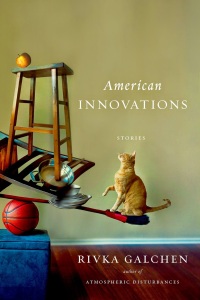
“But one day I woke up and heard myself saying, I am a fork being used to eat cereal. I am not a spoon. I am a fork. And I can’t help people eat cereal any longer.”
After a strange caller angrily denounces her for a missing Chinese take-out order, the narrator of “The Lost Order,” comes to some startling conclusions about her marriage and herself.
“The Region of Unlikeness,” is about another lost soul who befriends two eccentric intellectuals at a coffee shop. She is secretly attracted to one of them and repelled by the other.
“American Innovations” bravely tackles magical realism, body image, and deformity.
“Wild Berry Blue,” is a wonderful coming-of-age story about a girl who has a crush on an ex-junkie who works at her favorite McDonalds.
In one story, “Once Upon an Empire,” a likable but possibly deranged narrator, loses all of her belongings. No one steals them; instead, in a magical realism way, they become mobile and literally walk away from her apartment.
She finds them in a dumpster but is reluctant to identify them to the police.
Less successful stories included in this collection are “Dean of the Arts” or “The Late Novels of Gene Hackman.”
Galchen’s collection was long-listed for the 2014 Scotiabank Giller Prize.
In a novel that’s sweetness served up with a side of realism, Walsh explores a small town’s inhabitants desire to live the best version of themselves. When a simple plywood cubicle with the word DNAMIX shows up at Johnson’s grocery story, it causes the good people of Deerfield to behave in outlandish ways.
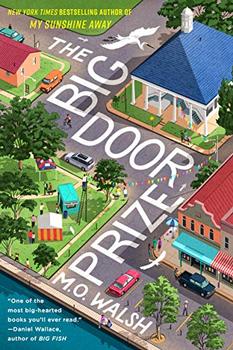
The machine, which does a quick DNA scan, determines if an individual has lived up to his or her potential. Ordinary townspeople suddenly decide they are meant to be puppeteers, Olympic champions, magicians, or members of royalty.
The townspeople’s gullibility infuriates Douglas Hubbard who feels the machine spits out random occupations. He is flabbergasted and irked to learn that his readout is spot-on. Even though Douglas wants a more exciting life, that of trombone player, the machine tells Douglas his life station is “teacher.”
Douglas has been a teacher for years and it leaves him depleted and exhausted. Every day that he teaches feels like eight days instead of one. Naturally, he is irked to find he is the only person in town given such a prosaic life station.
Most of the characters are humorous and endearing. Pat, Deerfield High’s principal, refuses to swear yet she uses nonsense words that sound suspiciously like swear words. Tipsy is the town’s only cab driver. He drives constantly, taking no money for fares, because it helps him keep a promise he has made to himself.
Father Pete is a good man even if he takes a drink now and then. The mayor nearly abandons his mayoral duties after getting his DNAMIX readout of “cowboy.”
Mixed in with the humor, however, is an unfolding mystery. What happened to the mayor’s son, Toby? Did he die from a DUI accident or was it something even more sinister? Beneath the amusing stories about Deerfield eccentrics, there is a darker story of the mistreatment of a young woman and the unquenched desire for revenge.
In March 2023, The Big Door Prize became an Apple+ television series.

Though I haven’t watched the television series, the novel certainly has comedic moments.
The Secret of Lost Things is a captivating literary who-done-it. After her mother dies, an eighteen-year-old from Tasmania makes a transformative journey to New York. Rosemary takes a job at the Arcade, a bookstore that sells everything from paperbacks to valuable rare books. At the Arcade she begins her unique education.
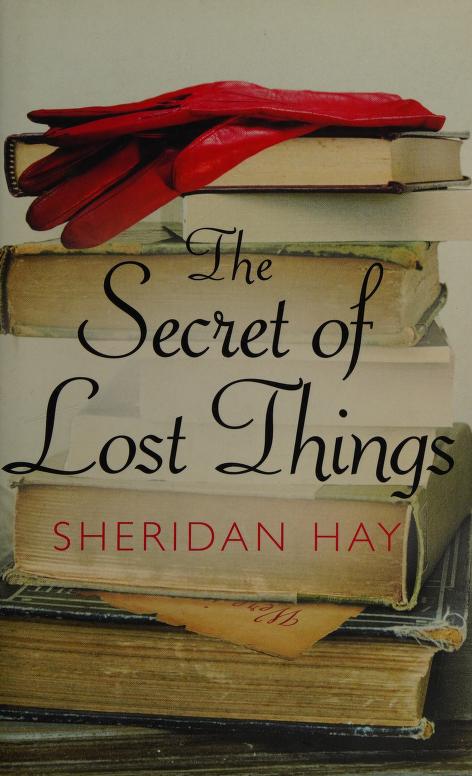
The Arcade’s employees are each eccentric in their own way. Mr. Pike is extremely parsimonious, Mr. Weiss is an albino, Mr. Mitchell looks like a large Australian bird, Pearl is a opera-singing transvestite, and Oscar is an emotionally-distant man who keeps Rosemary under a Svengali-like thrall. Rosemary, however, feels they each have something to teach her.
Like Ahab in Moby-Dick, each of the characters is obsessed with something. Instead of a whale, all seem to be obsessed with finding a lost Herman Melville manuscript, The Isle of the Cross.
Each of the characters in the Arcade are objects in a Wunderkammen; in fact, Hays has Rosemary visit Peabody’s Wunderkammen. Mr. Weiss views Rosemary as a “curiousity” because she comes from Tasmania and because of her wild, red hair.
In Mr. Mitchell and Mr. Pike, Rosemary tries to imagine a benevolent and stern father. She is herself, like Ishmael of Moby Dick, an orphan searching for her identity.
In a subplot, Hays introduces Lilian and her son Sergio, one of the “lost” from Argentina’s dirty war.
At his request, Rosemary begins a strange collusion with Oscar Jarno. She also becomes, against her will, an assistant to Mr. Weiss. In a sense, she is their object to do with what they will; that is, until she breaks free from their spell.
Repressed desire, madness, revenge, embezzlement, betrayal, and the lost manuscript by Herman Melville all play a part in this auspicious literary debut.
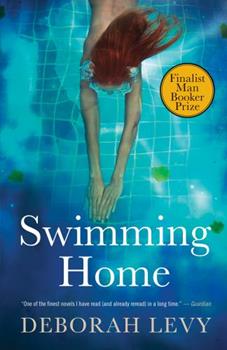
“You have to take a chance don’t you? Its like crossing the road with your eyes shut…you don’t know what’s going to happen next.” –Kitty Finch.
Nina decides that standing near Kitty “was like being near a cork that had just popped out of a bottle.” Nina thinks Kitty is a wild, adventurous spirit.
Jurgen wants to marry Kitty; Madeleine Sheridan is afraid of Kitty and thinks she is “mad.” Joe thinks she’s depressed and a dangerous groupie.
Kitty, a botanist, is unlike any house guest he’s ever met. She has stopped taking her medication and sees people walking through walls.
Kitty is also beautiful with a habit of walking around sans clothes.
Kitty’s poem, which she calls a conversation, is called “Swimming Home.” In it, she calls the pool a “coffin” so its easy to surmise her intentions.
Joe who pretends he hasn’t read her poem does not want to accept consequences. He warns his daughter not to get in a car with her, but then, surprisingly, he takes Kitty out for drinks at the Negresco.
Maybe its her madness that make her vision clearer, like the fool in King Lear. She gives a spooky foreshadowing of events:
“I know what you’re thinking. Life is only worth living because we hope it will get better and we’ll all get home safely. But you tried and you did not get home safely. You did not get home at all. That is why I’m here…I have come to France to save you from your thoughts.”
Nothing is as it appears in this novel about two couples vacationing in France. Everything rings true, however. The characters are well-developed and the scenes are well crafted.
This startling novel was shortlisted for the Man Booker prize.